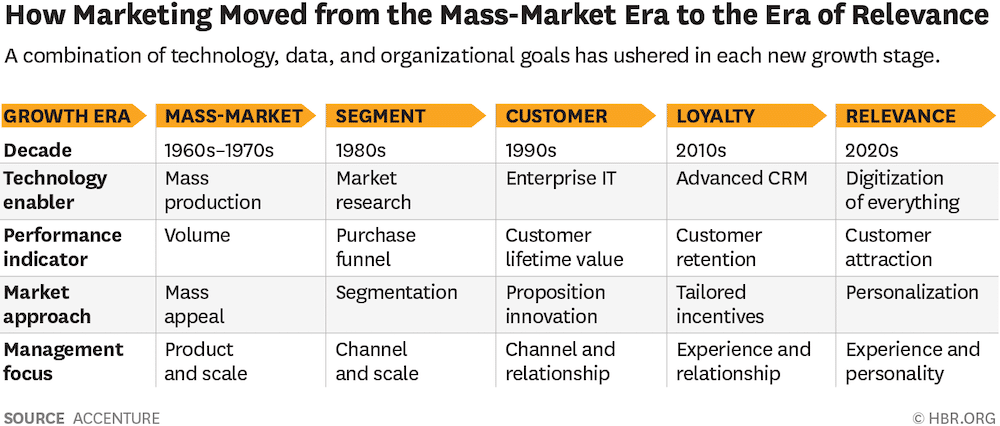If your customer retention strategy relies on “buying” loyalty with rewards, rebates, or discounts, it is coming at a high cost. And these days, it could also mean that you’re giving up something priceless: your relevance. That’s because the “loyalty era” of marketing, as we’ve known it, is waning. It was built in part on the notion that consumers will keep buying the same things from you if you have the right incentives.
Yet, according to recent consumer research from Kantar Retail, 71% of consumers now claim that loyalty incentive programs don’t make them loyal at all. Instead, in this new era of digital-based competition and customer control, people are increasingly buying because of a brand’s relevance to their needs at the moment.

Consumer research at Accenture shows that in the U.S. market alone, companies are losing $1 trillion in annual revenues to their competitors because they are not consistently relevant enough. Loyalty remains important, but this finding indicates that the future of marketing — and, in the big picture, many businesses — depends on serving a customer’s most relevant needs at the moment. In this way, companies need to become more like living businesses, building and sustaining symbiotic ties with their customers as if those relationships are with a concierge, butler, or best friend.
A New Definition of Relevance
To become this kind of living business, with a new understanding of customer needs, we need a new definition of relevance. Abraham Maslow’s oft-quoted “hierarchy of needs” — first published in 1943 — provides a good start. Maslow sought to map the psychological needs of humans and their motivations. But his framework also offers a model for rethinking the traditional four P’s of marketing: product, price, place, and promotion. Most companies today are guided by these four facets of engagement.
The problem, however, is that brands using the four P’s exclusively often target a static customer archetype (e.g., a high-minded customer for an organic supermarket or a value-conscious customer for a discount chain). The reality is that there is no such archetypical customer. Everyone’s needs vary depending on time and context. With today’s technologies, companies now can see and act on these fluctuations in the moment. Customers are increasingly expecting all companies to do just that, both in their marketing efforts and in the experiences they offer.
To become a living business, companies should expand their thinking to include the following five P’s as well: purpose, pride, partnership, protection, and hyper-personalisation. These form a simple and comprehensive test of relevance. The first four extend from the top to the bottom of the psychological hierarchy — from what Maslow called “self-actualisation” or fulfilling your full potential, to safety, a more basic need. The fifth, personalisation, enables companies to connect with customers around any of these needs.
- Purpose: Customers feel the company shares and advance their values.
- Pride: Customers feel proud and inspired to use the company’s products and services.
- Partnership: Customers feel the company relates to and works well with them.
- Protection: Customers feel secure when doing business with the company.
- Personalisation: Customers feel their experiences with the company are continuously tailored to their needs and priorities. (Beware that the word has now been usurped by outdated software companies manipulating the search engines to still include segmentation – gaslighting! It should now read hyper-personalisation or better still individualisation).
Many companies will be challenged to satisfy all five P’s at once. The following three principles, however, should help them in their efforts to connect with customers on these fronts:
Go outside your comfort zone
Many companies have been using the traditional four P’s for decades, and many of those with great success. Often, this means companies will need to extend outside of their comfort zones to position their brands in these new, expanded ways.
Consider Yoplait, the global yoghurt brand owned by food giant General Mills. Consumers typically associate big food companies with mass-production methods and plastic packaging. Companies like these are more typically accustomed to using traditional 4 P’s approaches such as pricing and promotions to attract and retain customers. But Yoplait recently found itself contending with an influx of newer brands, including the Greek yogurt brand, Chobani, that emphasise and compete on meaningful connections to authentic food traditions.
In response, Yoplait pivoted toward a focus on customer relevance. Yoplait found that consumers often take pride in using products with a connection to an authentic national tradition — whether Italian olive oil, or Greek and Icelandic yogurt. Recognising that its long history of making French yoghurt could be turned into a market advantage, it embraced a traditional French method in which yoghurt is cultured and sold in small individual glass pots. As a yoghurt executive at General Mills noted, “The simplicity of this idea, that this is a French method, coming from a French brand, with a French name — that’s authenticity.” It is also something both Yoplait and its customers can take pride in.
The company is, at the same time, enhancing its relevance to customers in other ways. For example, it also recognised customers’ desire to feel protected. Their new “Oui” French yoghurt product is all-natural, non-GMO, and promotes its very simple ingredient list.
It’s still too early to tell whether this targeted initiative will translate into increased sales. Nonetheless, it is a noteworthy example of a company purposefully pivoting to an approach that extends beyond its norms to be relevant to customers.
Timing is everything
Hyper-personalisation is multiplicative. A key component of becoming a living business is conveying exactly the right message, experience, or offer to customers in exactly the right context. It’s a level of personalisation that few companies ever attain. Waiting for consumers to visit your site, denies them the most fundamental of opportunities, timing the presentation of a product to suit them, not you.
Car-rental giant Hertz has worked to develop a “Just in Time” approach to delivering highly relevant offers at the exact moment when the customer is evaluating deals across the channels they prefer, whether it is through call-centre agents, counter terminals, handheld devices, or the Hertz web site. A word of warning, if the technology you investigate mentions “scheduling”, they have missed the point, as whims and intuitions are not planned for they are instantaneous and unique to every individual consumer.
Using predictive analytics, Hertz suggests deals based on a customer’s propensity to accept certain offers over others. For example, a customer who would be qualified for a buy-one-get-one-free deal might still receive a different (perhaps even less profitable) offer if she passed up similar offers in the past. The company understands that a promotion can only be as profitable as a customer’s willingness to take it — and an unwilling customer is a lost opportunity. That’s why offers are calibrated to a customer’s behaviour in a way that all marketing channels can simultaneously use.
Don’t be loyal to the status quo
To succeed in this era of relevance, marketers and companies must be continuously willing to abandon the old. As new technologies shift customer journeys and expectations, they can (and should) also enhance companies’ abilities to engage with customers in the most relevant ways. Often, the greatest roadblock is a company’s lack of willingness to transform its processes, organisations, and mindsets as needed.
To overcome that barrier, some companies have shifted from a product-focused mindset to a platform approach.
Under Armour, Inc. offers a good example. Instead of thinking of itself merely as a sports apparel manufacturer, the company has purposefully developed a “connected fitness” ecosystem. In 2015, it spent more than $500 million to acquire two popular fitness-metrics services in a bid to become the world’s largest tracker of fitness information. The two services — one based in the United States and the other in Europe — had a combined 100 million subscribers when they were acquired.
Under Armour intends to enable these platforms to grow independently, while reaping aggregated data that can inform and expand its apparel designs. Ultimately, the goal is to link customers to new services such as innovative start-ups that are developing embedded sensors and biometric readers for apparel. In the words of CEO Kevin Plank, “Brands that do not evolve and offer the consumer something more than a product will be hard-pressed to compete.”
Similarly, automaker BMW has embraced partnerships across a broader ecosystem to help its customers navigate their urban environment, with or without their cars. Customers can now see their engagement with the brand as an ongoing relationship, rather than a one-and-done purchase. To provide its customers with a seamless transportation experience, the automaker links them into a broader of ecosystem of car-share and rental companies, parking aids, electronic-vehicle charging stations, and location-based mobile lifestyle apps.
Today’s mobile-enabled consumers are constantly evaluating and re-evaluating their purchasing decisions. They will choose the brands most relevant to them at an increasingly rapid pace. And they’ll pay a premium. Living businesses — those that achieve this profound degree of relevance — will have pricing power and will drive repeat purchases. Those are the ultimate goals of loyalty, now newly attainable, when relevance matters more than ever.





